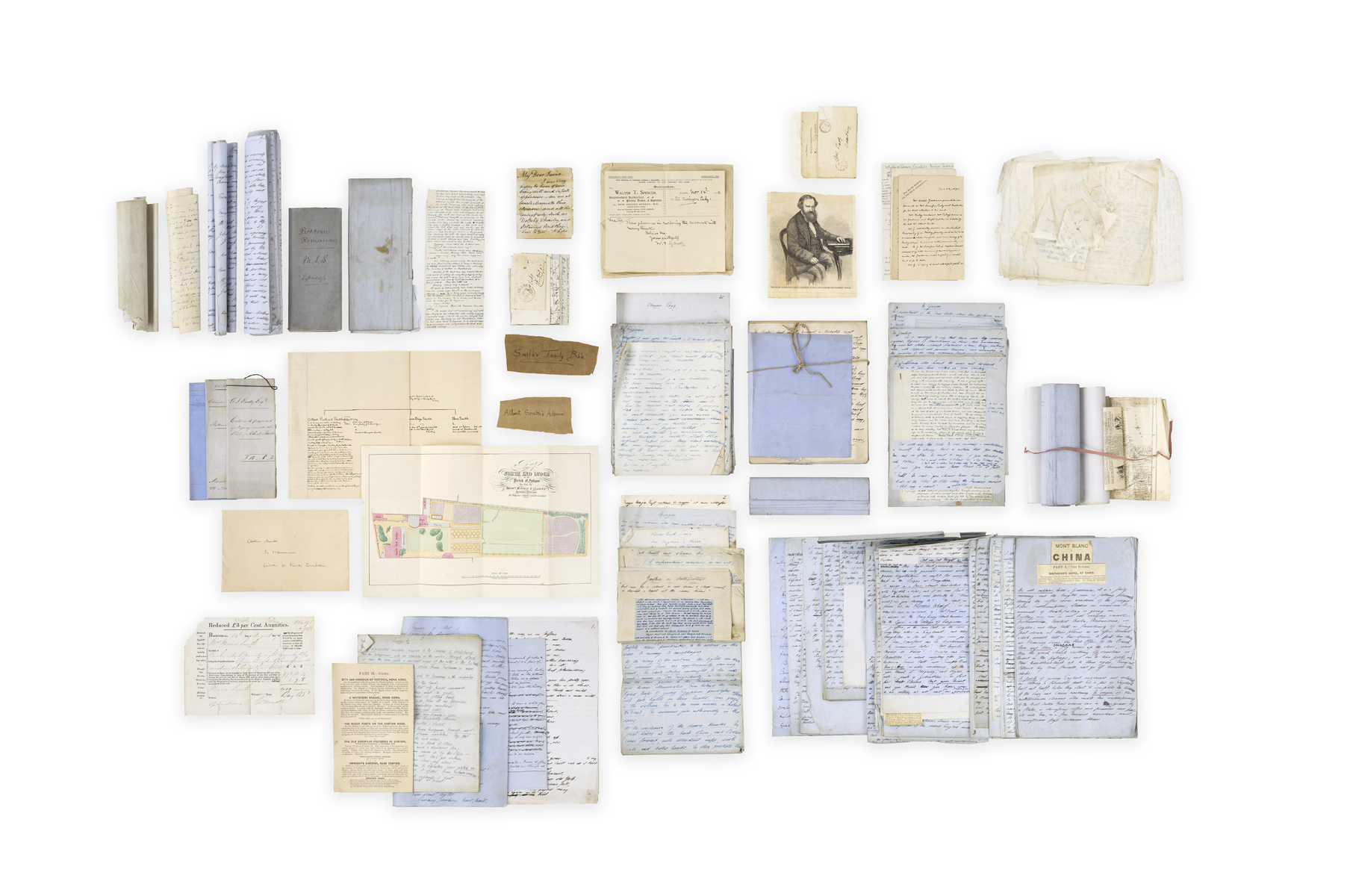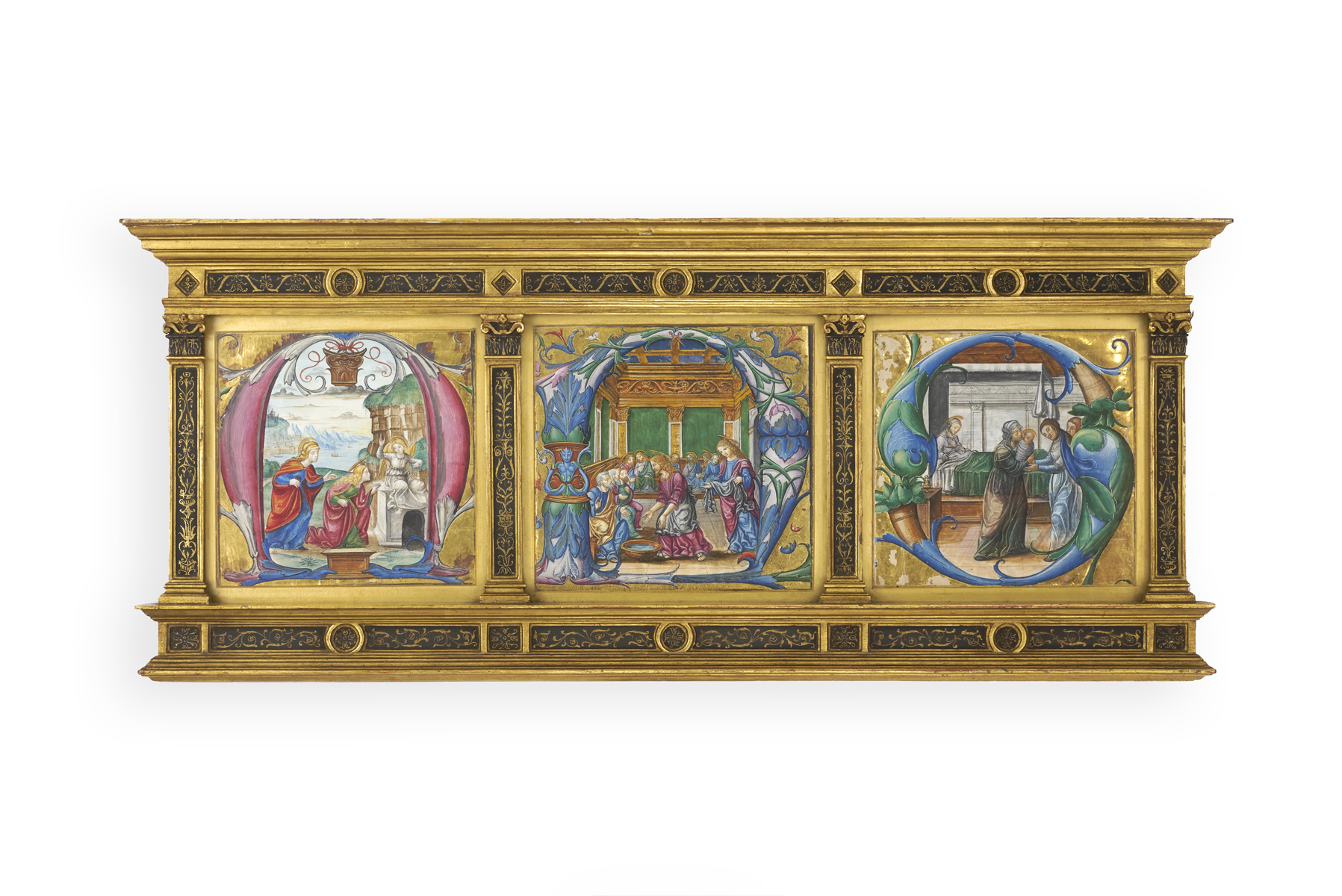
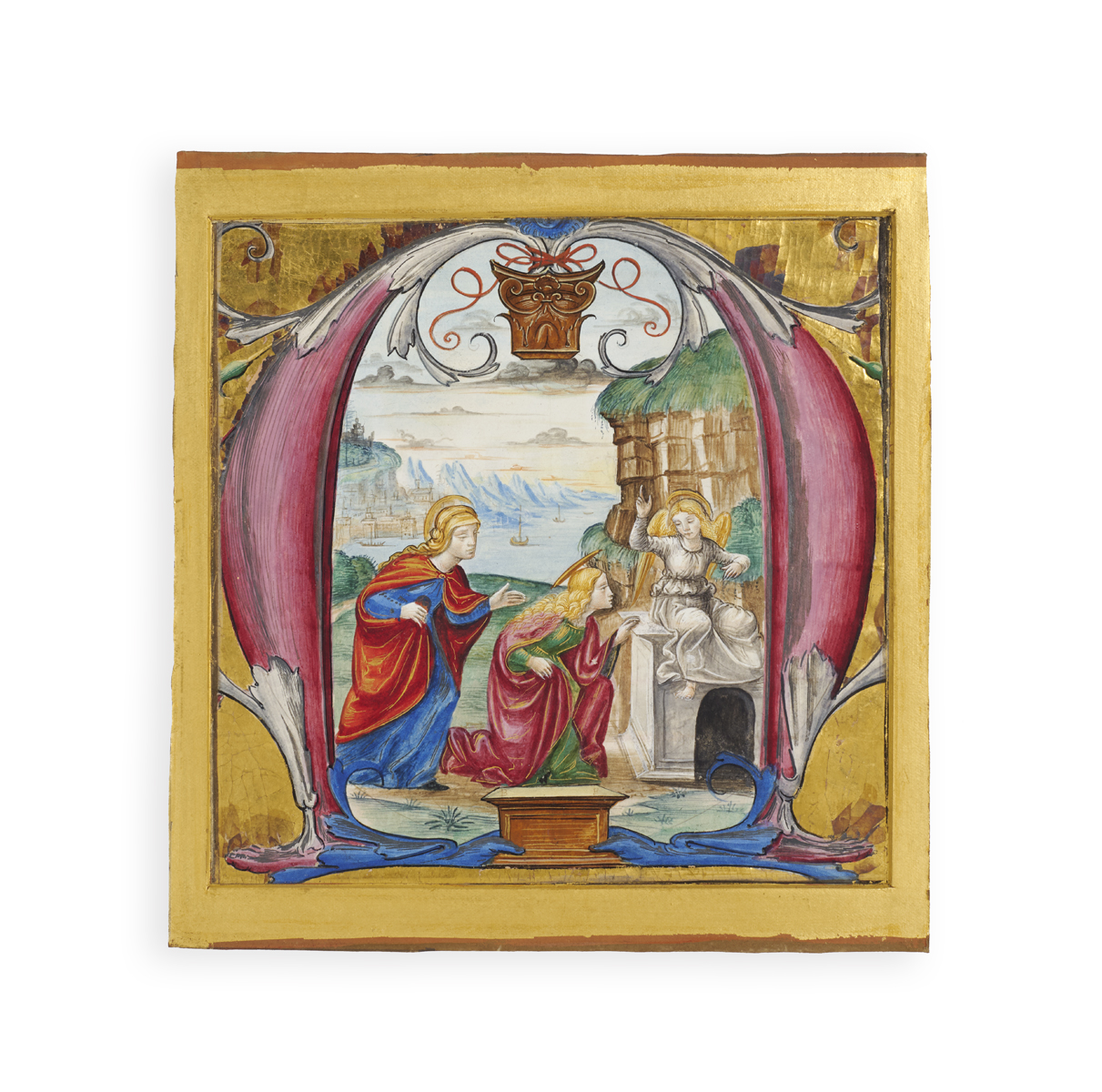
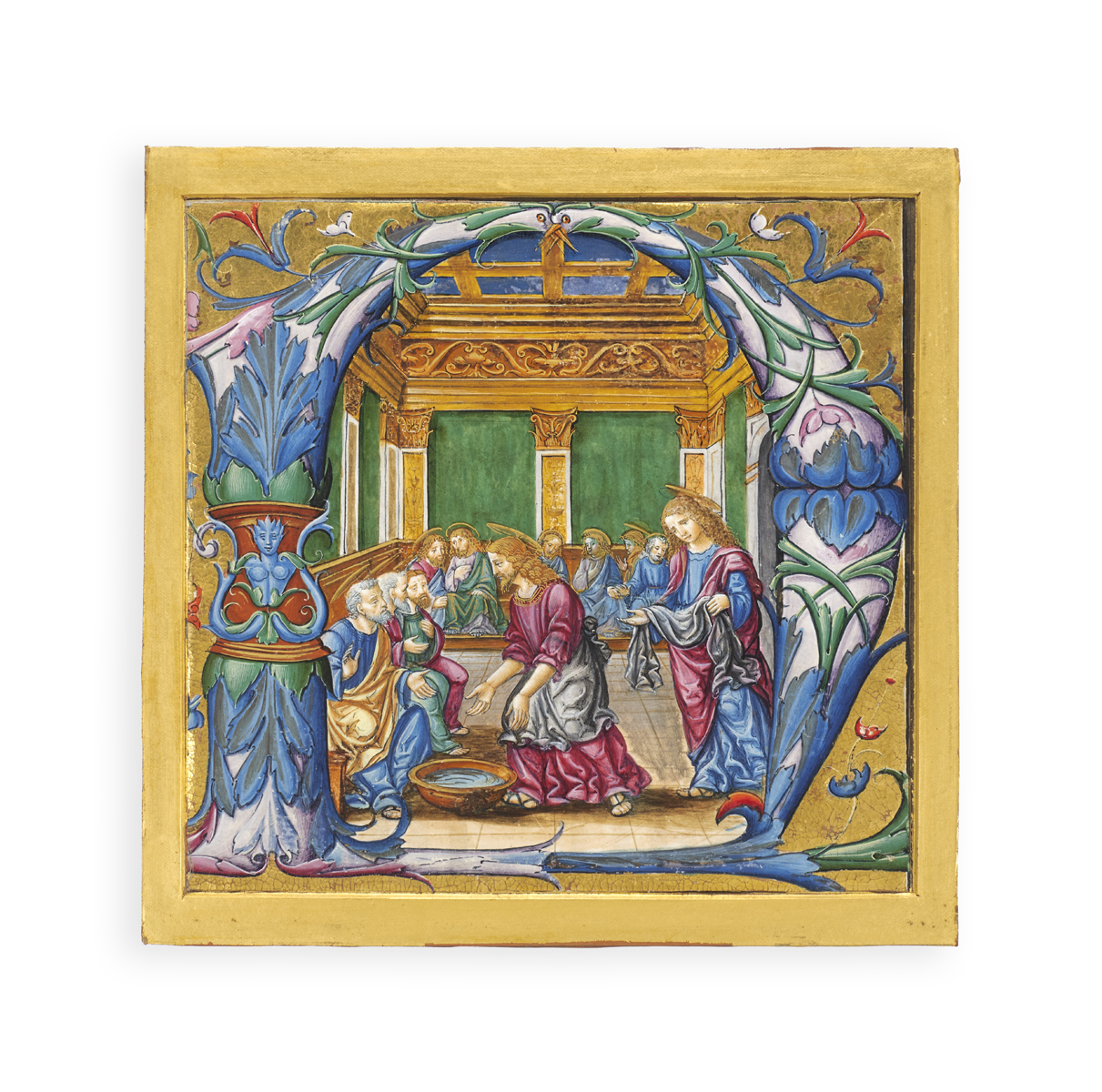
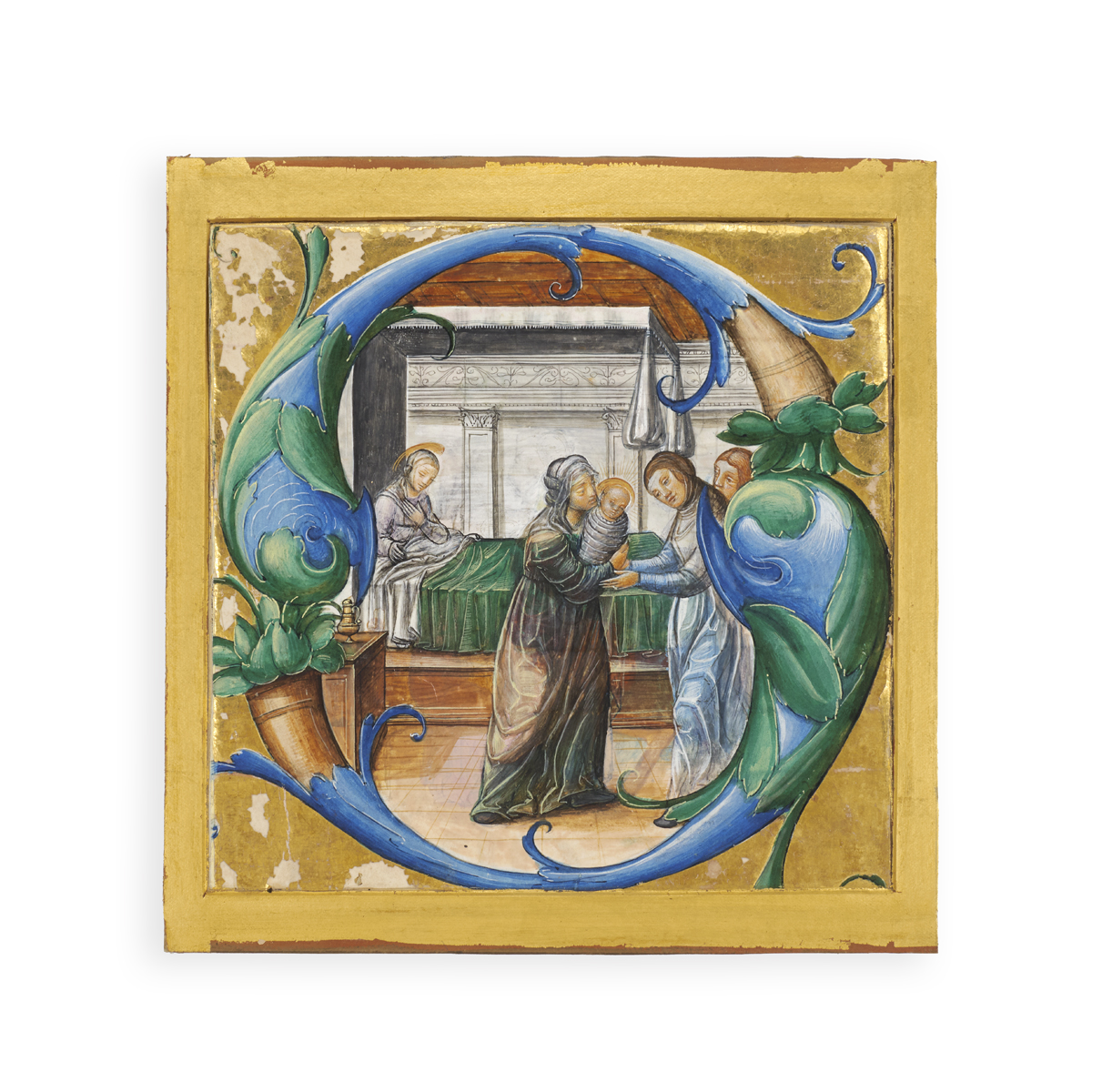
MASTERPIECES OF HIGH RENAISSANCE LOMBARD ILLUMINATION
MASTER B.F.
Three very large historiated initials cut from a set of choirbooks.
Italy (Lodi), early sixteenth century.
(i) Very large initial ‘M’ (161 x 164 mm, perhaps introducing the chant Maria Magdalena et altera Maria for Easter Monday in an Antiphonal) enclosing a scene of the Two Maries and the Angel at the Tomb set before a fine dawn landscape, a large rocky outcrop behind the tomb, the outer stems of the ‘M’ terminating in human feet, the central stem indicated at the head by a suspended classical capital and at the foot by a column base on which appear the small initials ‘B F’, the column base clasped by two blue human hands which emerge from the foliage attached to the outer stems of the ‘M’, the whole delicately painted in colours and silver (oxidised), heightened in gold and set against a burnished gold ground; some surface cracking and slight discolouration of the burnished gold, otherwise in excellent condition; pasted into a card mount.
(ii) Very large initial ‘N’ (169 x 177 mm, perhaps introducing the chant Nos autem gloriari for Maundy Thursday in a Gradual) enclosing Christ Washing Peter’s Feet, St John standing behind Christ with a towel, set within a richly decorated classical room around which eight other disciples are seated, the initial ‘N’ itself partly encased and entwined by elaborate foliage and incorporating a grotesque bust and two birds’ heads whose beaks interlock at the top centre, the whole delicately painted in colours and silver (oxidised), heightened in gold, and set against a burnished gold ground; some retouching of an area of the frieze and the coffered ceiling where evidently once damaged, some surface cracking of the burnished gold, otherwise in excellent condition; pasted into a card mount.
(iii) Very large initial ‘S’ (162 x 166 mm, perhaps introducing the chant Salve sancta parens in a Gradual) enclosing the Birth of the Virgin, St Anne lying in a canopied bed with a green coverlet and the baby, in swaddling clothes, being handed by a nurse to a woman in the foreground, the initial ‘S’ formed of two stylised dolphins whose tails terminate in cornucopias, the whole delicately painted in shades predominantly of blue, green, brown, and grey and set against a burnished gold ground; some flaking of the burnished gold along the left-hand side of the initial, otherwise in excellent condition; pasted into a card mount.

Added to your basket:
Three very large historiated initials cut from a set of choirbooks.
Three extremely fine initials by the enigmatic artist known as Master B.F., one of the most inventive and accomplished illuminators of the Italian High Renaissance. They come almost certainly from a magnificent set of about twenty choirbooks belonging to the Olivetan monastery of Santi Angelo e Niccolò of Villanove Sillaro in the diocese of Lodi, near Milan, which was suppressed in 1799.
‘Master B.F.’ is the name first assigned in 1931 to the artist of the Villanova Sillaro initials by Paul Wescher, who in 1960 suggested that he was to be identified with Francesco Binasco (Francesco da Lonate, also known as ‘il Binasco’) and that the letters ‘B’ and ‘F’ stood for ‘Binascus Fecit’. While ostensibly rather implausible, some of the artist’s initials are signed simply ‘B’. Francesco da Lonate was an illuminator, goldsmith and engraver documented as occupying the official positions ‘revisore’ of the Mint and ‘miniatore ducale’ under the Sforza dukes Massimiliano Maria (1512–1515) and Francesco II (1521–1535). However, since Binasco is not recorded before 1513 (Master B.F’s activity is datable from 1490 onwards) and no documented works by him have been discovered with which to compare the miniatures signed by Master B.F., Wescher’s theory remains controversial. The only documented illuminator at Villanova Sillaro at the right time is Fra Giovanni da Verona (c. 1457–1525).
‘Scholars have situated Master B.F.’s artistic production within the Leonardesque school of painting that developed in Lombardy in the early 1500s, identifying derivations of both figural types and compositional motifs in the monumental works of Leonardo da Vinci who was active in Milan from about 1482 to 1499 and again from 1506 to 1513. For example, the illuminator closely modelled the composition of the Virgin and Child with the infant Saint John and the Angel in an initial N (Chantilly, Musée Condé, n. inv. Divers, VI. 402, X) on the second version of the Virgin of the Rocks (London, National Gallery) which was on public view at San Francesco Grande. Master B.F.’s oeuvre also displays his awareness of trends in contemporary art from across the Alps, most notably engravings of Albrecht Dürer of the late 1490s from which he copied architectural elements for his landscapes’ (Anne-Marie Eze, ‘Master B.F.’, in S. Hindman and F. Toniolo, eds, The Burke Collection of Italian manuscript paintings, 2021, pp. 354-356, at p. 354).
The influence of Leonardo is most evident here in the scene of Christ Washing Peter’s Feet. The interior setting, with its walls and coffered ceiling rendered using central perspective, immediately brings to mind Leonardo’s Last Supper. Here, as there, the vanishing point lies just adjacent to Christ’s head, and the eye is therefore led down his left arm and towards the basin of water on the floor.
The initial depicting the Birth of the Virgin is of particular interest for showing signs of a radical change of composition during its creation. Among several obvious adjustments, the present large figure of a nurse holding the swaddled baby is painted over the bed, while the faint outline of a figure (looking down towards St Anne and perhaps holding a baby) is visible behind the bed, as is that of a sideboard on which lies a dish or bowl. These changes are especially interesting when our initial is compared with another by Master B.F. now in the Kupferstichkabinett in Berlin. There, in a remarkably similar composition used to depict the Birth of John the Baptist, a servant (holding a tray) and a sideboard are positioned behind the bed of St Elisabeth (Min. 4214; see B. Alai, Le miniature italiane del Kupferstichkabinett di Berlino, 2019, p. 302, no. 91); as if to avoid any possible confusion with the present initial, the Berlin initial is labelled ‘S. HELISABETH’ in the space above the saint’s bed.
The initials are framed together in a striking Italian Renaissance-style frame made for their former owner Sir George Holford in the early twentieth century. As far as we are aware, aside from the present initials only those by Master B.F. now at Birmingham City Art Museum are still preserved in Holford’s frames.
Provenance:
1. The Olivetan monastery of Santi Angelo e Niccolò on Villanova Sillaro at Lodi, near Milan.
2. Almost certainly the Abbate turned art dealer Luigi Celotti (1759–1843), although not among the cuttings by Master B.F. in the Christie’s sale of Celotti miniatures of 26 May 1825.
3. William Young Ottley (1771–1836); sale, Sotheby, 11 May 1838, apparently lots 79 (iii), 92 (ii), and 101 (i; one of two initials in the lot).
4. Robert Stayner Holford (1808–1892), art and plant collector and reputedly the richest commoner in England. ‘Holford began to collect works of art in 1839 and became one of the most distinguished collectors of his time, with an enthusiasm for the Italian Renaissance. The diarist A.N.L. Munby described him as “a collector with an eye for quality and the means to indulge it without stint”. No doubt in tribute to the superb quality of his illuminated manuscripts and early printed books, he referred to Holford as the “Ideal Connoisseur”’ (ODNB).
5. Sir George Holford (1860–1926); sale, Sotheby, ‘The Holford Library. Part I. Catalogue of the magnificent series of illuminations on vellum’, 12 July 1927, lot 33, bought by the collector, dealer, and forger Felix Joubert (1872–1953).
6. Sotheby, ‘Fine Western and Oriental Manuscripts and Miniatures’, 7 December 1953, lot 22 (‘the property of a lady of title’), where bought by the dealer Francis Edwards (against Maggs).
7. John Percival Love (1896–1974), Chairman of Francis Edwards; thence by descent.
References:
See G.M. Canova, Miniature dell’Italia settentrionale nella Fondazione Giorgio Cini, 1978; M. Carminati, Codici miniate del Maestro B.F. a Casorate Primo, 1995; A. de Floriani in F. Todini, ed., Museo Civico Amedeo Lia. Miniature, 1996, pp. 92-4, no. 18; P.L. Mulas in Enluminures italiennes. Chefs-d’oeuvre du Musée Condé, 2000, pp. 59-60, no. 15; J. R. Tannis, ed., Leaves of Gold. Manuscript illuminations from Philadelphia collections, 2001, pp. 179-81, no. 62; and P. Palladino, Treasures of a lost Art (2003), pp. 142-3, no. 70.

